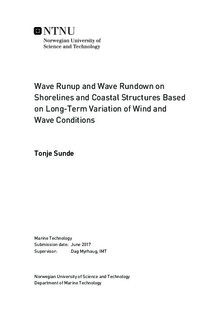| dc.description.abstract | In the resent years the fear of violent storms occuring more often, and with increasing violence, has drawn new attention to research on wave runup and wave rundown. Severe storm conditions could cause great damage on coastal infrastructure, buildings, and the land itself; both due to flooding and direct impact from waves.
Since wave runup is an important design parameter for coastal protection work, it is important to have reliable methods to predict this parameter. This thesis presents a method for estimating wave runup and wave rundown based on wind and wave statistics, and is based on published methods. Both wind and wave statistics were applied to the method, and several empirical wave runup and wave rundown equations were used to provide results.
Based on general equations representing the empirical equations, a formulae was obtained for wave runup and wave rundown as a function of wave period, significant wave height, and bottom slope. Through a Phillips spectrum this formulae was further modified to be a function of mean wind speed. Both wind and wave distributions were applied to the associated version of the formulae to generate results. Also, extreme values were found based on the probability of exceeding once every n-year for the wind distributions, and from environmental contour lines for the wave distributions.
Results obtained by the different empirical equations showed that some of the equations generated estimates significantly different from the others. However, these equations are developed from different conditions, and deviations in results are therefore expected. The extreme value estimates, which are important in design, did in general lie outside the range of validity of the empirical equations, and they were therefore based on extrapolation with associated uncertainty.
This method could be convenient to use due to its simplicity, but because of large uncertainties it should only be used in early estimates followed by more accurate analysis. | |

